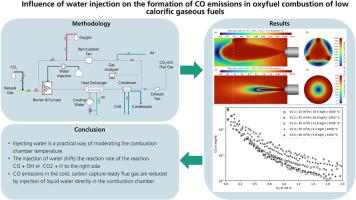Influence of water injection on the formation of CO emissions in oxyfuel combustion of low calorific gaseous fuels
IF 6.2
2区 工程技术
Q2 ENERGY & FUELS
引用次数: 0
Abstract
Oxyfuel combustion is a promising approach to apply carbon capture and thus counteract global warming. The pure oxygen used as an oxidizer is usually diluted with CO2, H2O or recirculated flue gas to moderate the combustion temperature, which influences the combustion characteristics like temperature distribution and CO formation. This paper deals with how the injection of liquid water in the combustion chamber affects the characteristics of MILD oxyfuel combustion of a low calorific natural gas/CO2 mixture, which is supposed to represent biogas. Experimental tests are carried out on a 50 kW pilot plant, where the amount of recirculated flue gas and the water injection rate are varied in order to determine whether the influences can also be measured in the cold carbon-capture-ready flue gas. Moreover, CFD simulations of the combustion process with and without water injection are conducted to better understand the influence of water injection on the combustion characteristics. Results show that the injection of water leads to lower CO emissions, measurable in the cold flue gas. Furthermore, the reaction CO + OH ⇌ CO2 + H, which is mainly responsible for CO combustion, is shifted to the right side, indicating a promotion in CO burnout. In addition, it is found that water injection is an efficient way of controlling the combustion chamber temperature in oxyfuel combustion systems without causing significant temperature peaks or strong inhomogeneities in the temperature field.

注水对低热量气体燃料氧燃料燃烧中CO排放形成的影响
氧燃料燃烧是一种很有前途的方法,可以应用碳捕获,从而抵消全球变暖。作为氧化剂的纯氧通常用CO2、H2O或循环烟气稀释,以调节燃烧温度,从而影响温度分布和CO生成等燃烧特性。本文研究了在燃烧室中注入液态水如何影响以沼气为代表的低热量天然气/二氧化碳混合物的MILD氧燃料燃烧特性。在一个50千瓦的试验装置上进行了实验测试,其中改变了再循环烟气的量和注水速度,以确定是否也可以在冷碳捕获的烟气中测量这些影响。此外,为了更好地了解注水对燃烧特性的影响,对有无注水的燃烧过程进行了CFD模拟。结果表明,在冷烟气中,注水导致CO排放量降低,可测量。同时,主要负责CO燃烧的CO + OH + CO2 + H反应向右侧偏移,促进了CO的燃尽。此外,研究还发现,在氧燃料燃烧系统中,注水是一种有效的控制燃烧室温度的方法,不会引起明显的温度峰值或温度场的强烈不均匀性。
本文章由计算机程序翻译,如有差异,请以英文原文为准。
求助全文
约1分钟内获得全文
求助全文
来源期刊

Journal of The Energy Institute
工程技术-能源与燃料
CiteScore
10.60
自引率
5.30%
发文量
166
审稿时长
16 days
期刊介绍:
The Journal of the Energy Institute provides peer reviewed coverage of original high quality research on energy, engineering and technology.The coverage is broad and the main areas of interest include:
Combustion engineering and associated technologies; process heating; power generation; engines and propulsion; emissions and environmental pollution control; clean coal technologies; carbon abatement technologies
Emissions and environmental pollution control; safety and hazards;
Clean coal technologies; carbon abatement technologies, including carbon capture and storage, CCS;
Petroleum engineering and fuel quality, including storage and transport
Alternative energy sources; biomass utilisation and biomass conversion technologies; energy from waste, incineration and recycling
Energy conversion, energy recovery and energy efficiency; space heating, fuel cells, heat pumps and cooling systems
Energy storage
The journal''s coverage reflects changes in energy technology that result from the transition to more efficient energy production and end use together with reduced carbon emission.
 求助内容:
求助内容: 应助结果提醒方式:
应助结果提醒方式:


